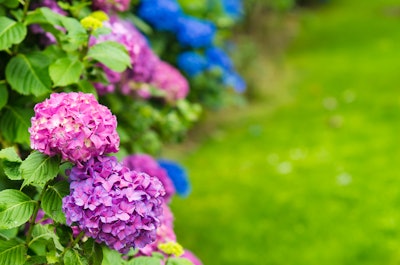
The bigleaf species, Hydrangea macrophylla, is the most iconic version of the shrub and can produce either blue or pink blooms.
“They have a wide appeal to the end consumer,” says Stacey Hirvela, a marketing specialist and horticulturist for Proven Winners. “People see them and want them, but that wouldn’t be enough if they weren’t easy plants to care for as well.”
It is often cited that simply changing the pH of the soil will change the color of these flowers, but there’s actually a little more to it than that, so here’s the breakdown of what’s actually happening and how you can help your customers get the color they desire.
The science behind the shades
It’s well-known that acidic soils (pH 3.3 – 5.5) produce blue blossoms and alkaline soils (pH 5.5 – 7.5) create pink flowers. Yet, this is only one part of the puzzle when it comes to petal pigmentations.
According to the Washington State University Extension, researchers discovered in the 1940s that anthocyanins are responsible for hydrangea coloration, as these pigments are not present in white hydrangeas, which are unable to change colors.
One of less talked about elements of hydrangea flower colors is the availability of aluminum in the soil. It is this metal that stabilizes the anthocyanin pigment complex. Without aluminum, the default petal color is red.
Because aluminum is toxic to plants, bigleaf hydrangeas sequester the aluminum in its flowers, turning the petals blue. The pH of the soil affects the availability of aluminum uptake, which is why acidic soils promote blue hydrangeas since there is more aluminum available to absorb.
So, if your client’s soil is acidic but their hydrangea is still a pink or reddish color, this means there is no aluminum in the soil. If there is aluminum present in the soil but the soil is alkaline, the flowers will also be pink in this case.
Hydrangeas in slightly acidic or neutral soils can result in flowers that are a mixture of pink and blue or purple on a single plant.
The Washington State University Extension also explains that aluminum alone cannot produce a blue color. A complex must be formed among three partners: a delphinidin with a sugar attachment, a phenolic acid co-pigment and aluminum. All three are required but genetic and environmental components also play a factor.
Changing flower colors
If your customer has asked you to alter the color of their hydrangeas, here’s how to go about doing so.
The first step to take is to conduct a soil test so you can determine your customer’s current soil pH. If you need to raise the pH levels, add lime. Avoid using too much lime, as this can cause new growth to yellow.
Aluminum sulfate or sulfur can be applied to lower pH levels. The University of Illinois Extension advises using sulfur, as it reduces the chances of aluminum toxicity.
When it comes to adjusting the soil pH, keep in mind that you will need to maintain the new level, as the soil tends to revert to its original pH.
If there isn’t enough aluminum in the landscape to create blue hydrangeas, it is better to grow these plants in containers and add an aluminum source, since other plants and organisms can be harmed by high aluminum levels.
Placement also plays a factor as to the intensity of the color. Hydrangeas in full sun have more vivid hues and sunlight is also needed to trigger anthocyanin production, so shaded flowers may have trouble accumulating a lot of this pigment.
Fertilizers low in phosphorous should be used to encourage blue flowers, as phosphorous tends to bind up aluminum.
Also, don’t rule out the importance of considering the cultivar. Bigleaf hydrangeas like ‘Pink Elf’ and ‘Glowing Embers’ can’t ever turn blue and may only achieve a purplish color, according to the University of Illinois Extension. Keep in mind that hydrangeas’ sensitivity to pH varies depending on the cultivar, as ‘Purple Tiers’ will remain purple except in the most acidic soils.
Whatever method you choose to modify your customer’s hydrangeas, be sure to stress that this sort of change won’t take place overnight. It can take several years, so remind clients to be patient if they don’t see results as quickly as they’d like.










